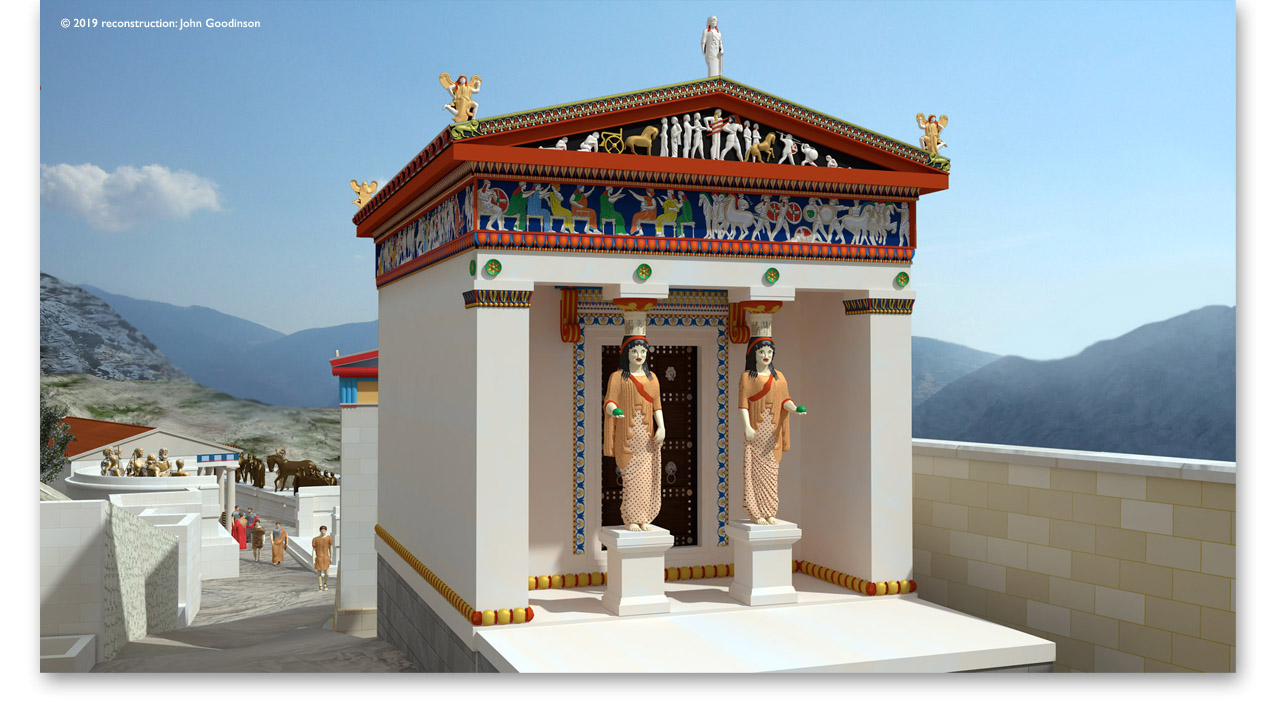Greek sculpture in the Archaic period evolved out of the eighth and seventh century "Daedalic" traditions of Crete and the Aegean islands. These traditions were brought to mainland Greece by itinerant sculptors and were dependent upon on the art of the Near East and Egypt.
Archaic Greek sculpture -- as evidenced by this Nike from Delphi - is frontal, symmetrical, "rigid," and informed by a deep regard for rectilinear structure and geometry; it also revels in color, surface details, and scintillating pattern.
The "archaic style" was never "stable," however, and showed a keen interest in "realism" from the early sixth century B.C.E. Indeed, by the end of the sixth century (ca. 520-500 B.C.E.), a full blown revolution was underway and by the beginning of the fifth century (ca. 500-480 B.C.E.), the beginnings of the "classical style" in Greek sculpture can clearly be seen. Above: conjectural placement of the nike acroterion on the Treasury of the Siphnians, Delphi.
Reconstruction (March 2019 update) of the Sanctuary of Apollo at Delphi circa 2nd century BCE. Scientific advisor: Professor Elena C. Partida. 3D Model: ©2019 John Goodinson.
Above: conjectural placement of the nike acroterion on the Treasury of the Siphnians, Delphi.
Reconstruction (March 2019 update) of the Sanctuary of Apollo at Delphi circa 2nd century BCE. Scientific advisor: Professor Elena C. Partida. 3D Model: ©2019 John Goodinson.
Greek sculpture of the Classical period takes nature - as opposed to geometry or tradition - as its direct inspiration. As can be seen by this famous Nike from Olympia, Classical Greek sculpture is three-dimensional, organic, "realistic," and informed by a deep regard for natural, internal organization. While Classical period sculpture was as heavily painted as its Archaic forerunners, sculptors of the fifth century saw paint as the means to compliment the sophisticated, plastic structure to which the paint was applied. This joining of art forms to a profound appreciation of the natural world on one hand and wildly competitive "marketplace" on the other that gave ultimate rise to the "Greek miracle" in Greek sculpture.
Nike stands upon the triangular marble pillar next to the black marble pillar in front of the temple of Apollo. Nike is now would like to thank professor Elena C. Partida for her extensive scientific guidance for the reconstruction of the sanctuary of Apollo at Delphi. Link: academia.edu


